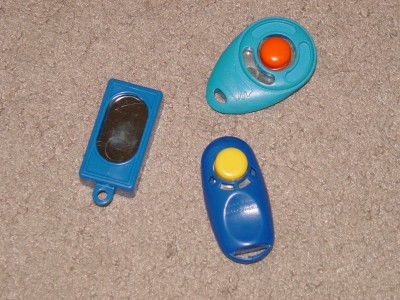© Copyright 2008 Nicole Wilde. Used with permission.
Clicker training is a fun and effective way to teach obedience exercises,
solve behavior problems, and even teach tricks!
Click here for a short video on the clicker.
Clicker training has been used with marine mammals for years, and is a clear, effective way to communicate with your dog. A clicker is a small plastic box with a metal tab that makes a clicking sound when pressed. The click acts as a marker to let your dog know the exact moment he is doing what you want. Why would your dog care if you click? Because each click is followed by a treat! Dogs learn quickly that “click equals treat,” so they try to figure out how to make us humans “click.” Why click instead of shouting, “Eureka!” or “You’ve got it!”? Because a click is faster and more precise than words. And the click sounds the same each time your dog hears it, whereas your verbal tone can vary.
There are various ways to get your dog to do something that will earn a click. Luring means leading your dog into position by having him follow a treat. Shaping means rewarding progressive bits of a behavior. For example, to get your dog to lie down from a sit, you might click and treat at first for a slight dip of the head, then for the head lowered further, then for head lowered further combined with one paw reaching forward, and so on until your dog was fully lying down. Luring and shaping are often combined. Capturing a behavior means clicking each time your dog happens to do it on his own. For example, if you click and treat each time your dog voluntarily makes eye contact, you will soon have a dog who is staring at you! In clicker training, we do not add the verbal cue (for example, “Down”) until after the dog is performing the behavior correctly. Once he’s “got it” and is freely offering the behavior, we simply add the cue just before the dog starts doing the behavior, thus creating an association in his mind. That allows us to then elicit the behavior by giving the verbal cue.
Although it might seem like a remote control, don’t point the clicker at your dog! If he is afraid of the sound, muffle the click by putting it in your pocket, putting a piece of tape over the metal tab, or using a ballpoint pen or a quiet brand of clicker such as the i-Click.
The clicker should not be used to get your dog’s attention; that would only confuse him. While the timing of the click is very important, almost no one has perfect timing at first. Don’t worry; your timing will improve with practice. In the meantime, if you click a bit early or late, your dog still gets the treat.
If your dog performs a behavior especially well, click only once, but give him a jackpot by offering a few treats in a row, along with especially enthusiastic praise.
Keep practice sessions short. Aim for three to five sessions of three to five minutes daily, broken into 30-second rounds; work on one behavior per round. Break up the rounds with short play/petting sessions. End each round and session on a good performance.
Change undesirable behaviors by clicking alternate ones. If your dog jumps, click for four paws on the floor or sitting instead. For a barking problem, click for silence.
When working on a behavior such as sit or down, after clicking, toss the treat a short distance away so your dog has to stand to get it. That sets him up for the next repetition.
You do not have to carry the clicker all the time! Once a behavior has been put on a verbal cue, you’re finished using the clicker for that particular behavior. But I hope you continue teaching your dog new behaviors its entire life — WITH A CLICKER! Have fun!
Text: Previous | Next
